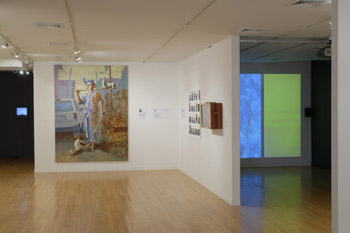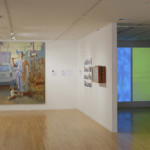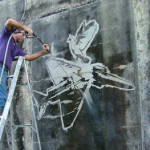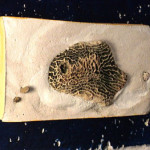By JON PETRO
"'America's Paradise' and 'Isla Del Encanto:' Contemporary Art from the American Caribbean," is a thematic group exhibition, containing over 20 varying types of artworks, from 12 emerging and established American Caribbean artists addressing the issue of the myth of paradise. As the exhibition's brochure points directly to “issues of identity, migration, and the complex economic, political, and social relationships with the U.S…” and an “often angst-filled conversation...” the exhibition itself offers a small and narrow view in content and style, of life under the motto "America’s Paradise."
There is a certain antiseptic vibe that can be found in most academic exhibitions; you come to expect a certain level of professionalism and rhetoric at this type of event. Since an exhibition without commercial concerns can hardly be viewed in terms of America’s capitalistic intent, an artist and curator can claim just about anything. Even though my aesthetic expectations are fulfilled on an academic level with the exhibition “America’s Paradise,” the show still seems somewhat limited. If the theme of this show is innocence lost due to consumerism, tourism, and misguided capitalism, why aren’t these artists offering us any creative solutions, rather than just complaints?
What struck me as odd in the bringing together of 12 artists working against “geo-political clichés about their homeland” is that nine of the 12 artists represented in the show have been educated in the United States, not the Caribbean. Not one artist in this exhibition truly reflects the home-grown art of the Caribbean; there is only a hint of it stylistically.
When did the contemporary art world become so gentrified? If this show was all indigenous Caribbean art in its context, would anyone in the contemporary art world really be interested? I see the need to become involved in the global dialogue of art, but I also feel that the culture of victimhood isn’t doing these artists any good. At first I thought this exhibition would have been a perfect vehicle to decry the ills of Globalization, but given its milieu--the Museum School--there doesn’t seem to be any need to make that point.
I can’t help but be suspicious of an artist’s sincerity in the ideas of art. Artists with comparable technical skills will grandstand current events and content to advance their careers. The funny part about it is that this is how the business of art is now done globally, or should I say trans-nationally?
SMFA Curator Joanna Soltan writes about artist Rafael Trelles, “… he creates politically-charged pieces that, as he says, aim to ‘influence the spheres of politics, economy, and anthropology, among others.’” Trelles is perhaps the most established artist represented in the exhibition. His life-sized painting, “Self-portrait after Paret” (2007), which is an homage to Spanish Painter Luis Paret y Alcázar’s 1776 “Self-portrait,” is an attempt at this concept.
Its background is a purple/yellow pastel-complimentary color scheme depicting an urban cityscape and rendered in an outline fashion with a darker earth tone. He creates the mid tones by padding the whole canvas with a paint loaded towel, creating a transparent repetitive abstract pattern much like a faux decorative painter would do. It seems to have all the material possessions of contemporary civil society: cars, multi-story dwellings, telephone poles and modern sewers. The foreground contains Trelles as Paret with two baby lambs; one of the lambs is balanced on a walking cane and held in his right hand over his left shoulder. The second lamb is at Trelles’ bare feet with its throat cut, by the sword in his left hand. He is a competent painter in his choice of style. I must stress that I use the word style and not content with all that it implies. There is a certain stiffness to this painting that I attribute to the fact the artist was working from a reproduction. For me, the symbolism of the painting is straightforward: the two lambs represent the USA and Puerto Rico, Trelles’ place of birth. I would suggest that Trelles believes one of these two locations has been sacrificed for the greater good of Capitalism and or the American way.
In juxtaposition to the projected righteousness of Rafael Trelles' art are the more sublime sculptures of Lucas Gasperi. He is more sentimental in his approach to the idea of innocence lost, which is represented by four small (8” X 6” X 1 ½”) wall relief pieces and one pedestal sculpture. Each is a combination of small stones, sea shells, concrete and gesso. Gasperi’s artwork has an organic fossil-like presence and is monochromatic by nature; I get the impression that he’s attempting to preserve his idea of America’s Paradise.
I reacted positively to these pieces because they relate more closely to the process of art rather than to the provocation of a political point of view. I’m not generally a big fan of sculpture or “mixed media,” but with all the bellicose chest-pounding coming off the other walls in the gallery it's just nice to hear someone whispering to get your attention.
Just as Rafael Trelles employs selective filters to arrive at his working political motif, such as an artistic historical larceny along with his own ancestry, I have chosen to not include the other 10 of the 12 artists in this exhibition in order to be able to question Trelles ideals. I have only once in my life witnessed any realpolitik art that was genuine. I'm not using the term in its pejorative sense. That work is Maya Ying Lin’s Vietnam Veterans Memorial Wall. It fulfills every aspect of what art should and can be. No one is confused after witnessing the memorial; you simply just understand the magnitude of the expression.
Just because I disagree with the function of Rafael Trelles’ political art as a form of art itself, it doesn’t mean I am viewing his works with my eyes closed. Imbued with a little common sense, I believe anyone can make their way back to their own idea of America’s Paradise, or at the very least manage to recreate what they think they’ve lost. After all, America’s streets are paved with gold and Rafael Trelles understands this all too well.
- Rafael Trelles. Self-portrait after Paret, Installation View. 2007. Photo by George Bouret
- Rafael Trelles, From the portfolio En concreto—grafica urbana en Vieques, 2005. Digital print documenting one of Trelles’ images created on the walls of abandoned Navy magazines on Vieques. 2006. Photo: Johnny Betancour
- Luca Gasperi, Historical Document 133.10, Concrete, stone, gesso acrylic, and coral, 2007.
Links:
School of the Museum of Fine Arts, Boston
"'America's Paradise' and 'Isla Del Encanto': Contemporary Art from the American Caribbean" is on view through October 13, 2007 at SMFA's Grossman Gallery.
All images are courtesy of the artist and the School of the Museum of Fine Arts.







